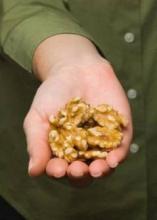Over a period of 12 weeks, men who added consumption of about two handfuls of walnuts per day to their diet experienced improvement in sperm vitality, motility, and morphology, compared with men who followed their usual diet.
The findings, published online Aug. 15 in the "papers in press" section of the journal Biology of Reproduction, mark the first effort to examine the effects of a plant source of omega-3 on human sperm, according to researchers led by Wendie A. Robbins, Ph.D., R.N., of the Fielding School of Public Health at the University of California, Los Angeles, and a professor at the UCLA School of Nursing.
"Women are not the only ones who should be paying attention to what they eat when they are trying to get pregnant," Dr. Robbins remarked in a press release. "This study shows that what men eat is important, too."
For the study, 117 men aged 21-35 years were randomized to one of two groups between October 2009 and September 2010: 58 who added 75 g of whole shelled walnuts to their daily diet (group 1), and 59 who continued their usual diet but avoided consumption of tree nuts (group 2). The researchers collected blood and sperm samples at baseline and 12 weeks. The primary outcome was improvement in conventional serum parameters and sperm aneuploidy (Biol. Reprod. 2012 Aug. 16 [doi: 10.1095/biolreprod.112.101634]).
Dr. Robbins and her associates found that compared with men in group 2, men in group 1 had significant improvements in sperm vitality (P = .003), motility (P = .009), and morphology (P = .03), as well as increases in serum measures of omega-6 (P = .0004) and omega-3 (P = .0007).
"Walnuts provide a particularly rich source of alpha-linolenic acid, a natural plant source of omega-3, which we suspect may have been responsible for the improvements we observed," according to study coauthor Catherine L. Carpenter, Ph.D., of the UCLA Center for Human Nutrition and the UCLA schools of nursing and medicine.
The study was funded through a grant from the California Walnut Commission and the UCLA Fielding School of Public Health’s Center for Occupational and Environmental Health.
–Doug Brunk (on twitter@dougbrunk)


